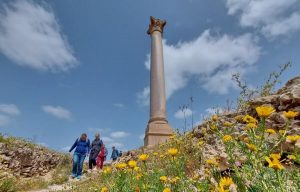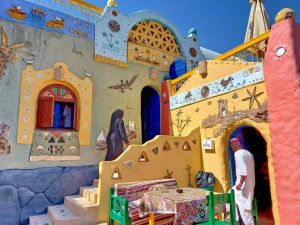The Grand Egyptian Museum (GEM), also known as the Giza Museum, is a proposed museum of ancient Egyptian antiquities. Its purpose is to guarantee that these riches are preserved for future generations. The museum is under construction and is scheduled to be partially open in 2021 and 2022, exhibiting the full Tutankhamun collection with various pieces being displayed for the first time. It is described as the largest archaeological museum in the world, capable of hosting 5 million visitors per year. The museum’s cost is $795 million, which is primarily supported by two loans from the Japanese government totaling $300 million.
Egypt’s Grand Egyptian Museum Overview
The design of the structure, like that of the Great Library of Alexandria, was selected through an architectural competition. The organizers launched the competition on January 7, 2002, and it got 1557 submissions from 82 nations, making it the second-largest architectural competition in history. During the second stage of the competition, only 20 entrants were requested to submit more details about their concept. The judging was finished on June 2, 2003. The firm Heneghan Peng from Dublin, Ireland won the competition, receiving $250,000 and the opportunity to see their concept come to reality, which you can book through our Egypt tours.
Design of the Grand Egyptian Museum
In the plan, the structure is shaped exactly like a chamfered triangle. The museum’s architecture makes use of the level difference to provide a new “edge” to the plateau, a surface defined by a veil of translucent stone that magically shifts from day to night. The museum is located between the Nile River and the plateau, never stretching over the entire plateau. It is located 2 kilometers west of the pyramids, at a highway junction. The north and south walls of the structure exactly align with the Great Pyramid of Khufu and the Pyramid of Menkaure.
- The new museum is planned to feature cutting-edge technologies such as virtual reality.
- The museum will also serve as an international communication hub for other museums, fostering direct engagement with other local and international institutions.
- The Grand Egyptian Museum will include a children’s museum, a convention facility, a training center, and workshops modeled after ancient Pharaonic sites.
- One of the most significant parts of the museum will be the restoration center, which will be 32 thousand meters long, 10 meters below, and connected to the museum by a 300-meter tunnel for transferring items after restoration.
- There are around 19 laboratories that will manage all sorts of conserving and repairing ancient Egyptian antiquities, such as a vase, glass, and metal lab, which handles any artifacts, vessels, or sculptures made of non-organic stuff.
- A wood lab that handles the repair of wooden artifacts such as covens, sculptures, funerary items, tools, ships, and sarcophagi.
- A stone’s lab, which, of course, looks after all of the sculptures on exhibit, from the largest to the tiniest.
- The microbiological lab preserves the artifacts by finding the sorts of living things that might destroy the artifacts, which the researchers eradicate by developing a chemical substance that would prevent this life form from harming the artifact.
- A microscope scanning lab, houses all of the instruments required for preparing and analyzing samples before sending them to the microbiological lab.
- A human remains lab known as the “Mummies Lab” is in charge of repairing the mummies of all the kings, queens, laborers, and even animals like cats and birds.
Area of the Grand Egyptian Museum
The Grand Egyptian Museum is located on a 50-hectare (120-acre) plot of land about 2 kilometers from the Giza pyramids and is part of a new master plan for the plateau. A wide courtyard in front of the building is filled with numerous date palms. The translucent stone wall constructed of pure alabaster that forms the front face of the building is one of the museum’s most notable characteristics. The museum’s main entrance has a huge atrium where big statues will be displayed. The Grand Egyptian Museum is planned to be a cultural complex of activities devoted to Egyptology, with 24,000m2 of permanent exhibition space, nearly four football fields in size, a children’s museum, a larger conference center, and education facilities, as well as extensive gardens on the 50th A site.
The real work began on February 2, 2010, when Hill International announced that Egypt’s Ministry of Culture had signed a contract with a joint venture of Hill and EHAF Consulting Engineers to offer project management services throughout the Grand Egyptian Museum’s design and construction.
The Grand Egyptian Museum’s Development
Egyptian deposed President Hosni Mubarak lay the groundwork for the Grand Egyptian Museum on January 5, 2002. The statue of King Ramesses II was transported from Ramses Square to the Giza Plateau in Cairo on August 25, 2006, in preparation for the construction of the Grand Egyptian Museum. The Ramesses II Statue, which is thought to be over 3,200 years old, was relocated near the museum’s entrance in January 2018.
GEM received a $300 million loan from the Japan Bank for International Cooperation in 2007. The Egyptian government will provide $147 million, with the remaining $150 million coming from contributions and international organizations.
On January 11, 2012, Egypt’s Orascom Construction Industries (OCI) and the Belgian BESIX Group launched a joint venture when they were granted the contract for phase three of the Grand Egyptian Museum (GEM), a transaction for $810 million, increasing the overall cost of the museum to $1.1 billion.
On April 29, 2018, a fire broke out at the GEM’s entrance, however, no artifacts were destroyed, and the source of the fire is still unknown.
The last of King Tutankhamun’s chariots were brought to GEM from overseas in May 2018.
According to Tarek Tawfik, GEM’s director, the estimated date for a complete formal launch in 2021 was determined in November 2018.
Grand Egyptian Museum Exhibits
The museum will occupy approximately one-third of the overall museum grounds, showcasing over 100,000 objects from various eras. The primary attraction of the museum will be the first exhibition of King Tutankhamun’s whole tomb collection, which will feature around 5000 pieces and will be moved from the Egyptian Museum in Cairo. Other items will be transferred from Luxor storage facilities and museums, including the colossal statue of Amenhotep III and a four-ton pink Granite figure of the deity Horus, as well as Aswan, Minya, Sohag, Assiut, Beni Suef, Fayoum, the Delta, and Alexandria.
Check out our Egypt tours 2022/2023 and plan your ideal holiday to Egypt to see all Egypt has to offer, including the Gand Egyptian Museum. We also offer Nile river cruises, which you may look into if you like.










